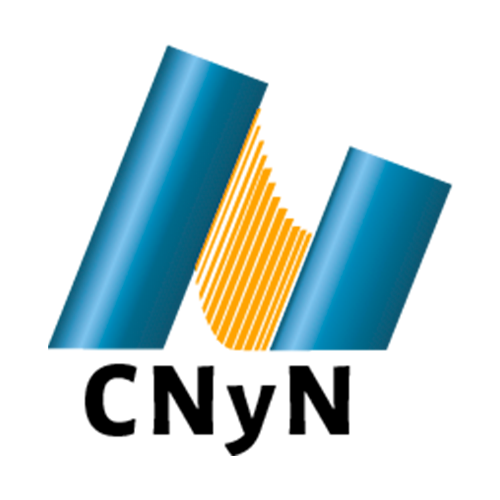Biosynthesis of silver nanoparticles with antimicrobial activity by environmental Pseudomonas aeruginosa
Main Article Content
Abstract
Silver nanoparticles (NPs-Ag) are of great interest due to the potential applications in different areas. In order to find methodologies that not represent human health risk and also an ecofriendly one, biosynthesis of these nanoparticles has been a viable option. It is known that diverse biomolecules present in microorganisms can function as an oxidative, reductor and/or stabilizer agents, thanks to that silver nanoparticles synthesis could be favored. In this work the main objectives were the biosynthesis, characterization, and evaluation of antibacterial activity of NPs-Ag. Biosynthesis was made using the culture supernatant of Pseudomonas aeruginosa. The NPs-Ag were characterized using UV-Vis spectroscopy, scanning electron microscopy, X‑ray diffraction and the antimicrobial effect was evaluated by dilution assays in Muller Hinton broth and the minimum inhibitory concentration (MIC) and minimum bactericidal concentration (MBC) were determined against Gram-positive and Gram-negative bacteria. A mixture containing 20% of supernatant and 3 mM AgNO3 was the best way to obtain silver nanoparticles. Nanoparticles with mixed morphology were observed. The NPs-Ag showed antibacterial activity over Gram-positive and Gram-negative bacteria with MIC of 1 to 2 µg/ml and MBC of 2 to 4 µg/ml. In conclusion, culture supernatant of P. aeruginosa is a viable pathway for the synthesis of NPs-Ag with antibacterial activity.
Downloads
Article Details

Mundo Nano. Revista Interdisciplinaria en Nanociencias y Nanotecnología por Universidad Nacional Autónoma de México se distribuye bajo una Licencia Creative Commons Atribución-NoComercial 4.0 Internacional.
Basada en una obra en http://www.mundonano.unam.mx.
References
Amendola, V., Bakr, O. M. y Stellacci, F. (2010) A study of the surface plasmon resonance of silver nanoparticles by the discrete dipole approximation method: Effect of shape, size, structure, and assembly. Plasmonics, 5: 85-97. https://doi.org/10.1007/s11468-009-9120-4. DOI: https://doi.org/10.1007/s11468-009-9120-4
Durán, N., Durán, M., De Jesús, M. B., Seabra, A. B., Fávaro, W. J. y Nakazato, G. (2016). Silver nanoparticles: a new view on mechanistic aspects on antimicrobial activity. Nanomedicine: Nanotechnology, Biology and Medicine, 12(3): 789-799. https://doi.org/10.1016/j.nano.2015.11.016. DOI: https://doi.org/10.1016/j.nano.2015.11.016
Filloux, A. (2011). Protein secretion systems in Pseudomonas aeruginosa: an essay on diversity, evolution, and function. Frontiers in Microbiology, 2, 155.x. https://doi.org/10.3389/fmicb.2011.00155. DOI: https://doi.org/10.3389/fmicb.2011.00155
Flores-Pantoja, L. E., Briseño-Silva, E, Loeza-Lara, P. D. y Jiménez-Mejía, R. (2022). Actividad antifúngica y características de promoción de crecimiento vegetal de Pseudomonas aeruginosa y Enterobacter sp. degradadoras de hidrocarburos aisladas de suelo contaminado. Acta Biológica Colombiana, 27(3). https://doi.org/10.15446/abc.v27n3.92758. DOI: https://doi.org/10.15446/abc.v27n3.92758
Franci, G., Falanga, A., Galdiero, S., Palomba, L., Rai, M., Morelli, G. y Galdiero, M. (2015). Silver nanoparticles as potential antibacterial agents. Molecules, 20(5): 8856-8874. https://doi.org/10.3390/molecules20058856. DOI: https://doi.org/10.3390/molecules20058856
Gul, S., Ismail, M., Khan, M. I., Khan, S. B., Asiri, A. M., Rahman, I. U., Kahn, M. A. y Kamboh, M. A. (2016). Novel synthesis of silver nanoparticles using melon aqueous extract and evaluation of their feeding deterrent activity against housefly Musca domestica. Asian Pacific Journal of Tropical Disease, 6(4): 311-316. https://doi.org/10.1016/S2222-1808(15)61036-2. DOI: https://doi.org/10.1016/S2222-1808(15)61036-2
Huq, M. (2020). Green synthesis of silver nanoparticles using Pseudoduganella eburnea MAHUQ-39 and their antimicrobial mechanisms investigation against drug resistant human pathogens. International Journal of Molecular Sciences, 21(4): 1510. https://doi.org/10.3390/ijms21041510. DOI: https://doi.org/10.3390/ijms21041510
Huq, M. A., Ashrafudoulla, M., Rahman, M. M., Balusamy, S. R. y Akter, S. (2022). Green synthesis and potential antibacterial applications of bioactive silver nanoparticles: a review. Polymers, 14(4), 742. https://doi.org/10.3390/polym14040742. DOI: https://doi.org/10.3390/polym14040742
Iravani, S. (2014). Bacteria in nanoparticle synthesis: current status and future prospects. International Scholarly Research Notices, 2014. https://doi.org/10.1155/2014/359316. DOI: https://doi.org/10.1155/2014/359316
Khan, I., Saeed, K. y Khan, I. (2017). Nanoparticles: properties, applications and toxicities. Arabian Journal of Chemistry, 12: 908-931. https://doi.org/10.1016/j.arabjc.2017.05.011. DOI: https://doi.org/10.1016/j.arabjc.2017.05.011
Kim, S. W., Chung, H. E., Kwon, J. H., Yoon, H. G. y Kim, W. (2010) Facile synthesis of silver chloride nanocubes and their derivatives. Bulletin of the Korean Chemical Society; 31: 2918-22. https://doi.org/10.5012/bkcs.2010.31.10.2918. DOI: https://doi.org/10.5012/bkcs.2010.31.10.2918
Kumar, C. G. y Mamidyala, S. K. (2011). Extracellular synthesis of silver nanoparticles using culture supernatant of Pseudomonas aeruginosa. Colloids and Surfaces B:Biointerfaces, 84(2): 462-466. https://doi.org/10.1016/j.colsurfb.2011.01.042. DOI: https://doi.org/10.1016/j.colsurfb.2011.01.042
Kumar, C. G., Mamidyala, S. K., Das, B., Sridhar, B., Devi, G. S. y Karuna, M. S. (2010). Synthesis of biosurfactant-based silver nanoparticles with purified rhamnolipids isolated from Pseudomonas aeruginosa BS-161R. Journal of Microbiology and Biotechnology, 20(7): 1061-8. https://doi.org/10.4014/jmb.1001.01018. DOI: https://doi.org/10.4014/jmb.1001.01018
Madani, M., Hosny, S., Alshangiti, D. M., Nady, N., Alkhursani, S. A., Alkhaldi, H., Al-Gahtany, S. A., Ghobashy, M. M. y Gaber, G. A. (2022). Green synthesis of nanoparticles for varied applications: Green renewable resources and energyefficient synthetic routes. Nanotechnology Reviews, 11(1): 731-759. https://doi.org/10.1515/ntrev-2022-0034. DOI: https://doi.org/10.1515/ntrev-2022-0034
Naganthran, A., Verasoundarapandian, G., Khalid, F. E., Masarudin, M. J., Zulkharnain, A., Nawawi, N. M., Karim, M., Che Abdullah, C. A. y Ahmad, S. A. (2022). Synthesis, characterization and biomedical application of silver nanoparticles. Materials, 15(2): 427. https://doi.org/10.3390/ma15020427. DOI: https://doi.org/10.3390/ma15020427
Pantidos, N. y Horsfall, L. E. (2014). Biological synthesis of metallic nanoparticles by bacteria, fungi and plants. Journal of Nanomedicine and Nanotechnology, 5(5): 1. http://dx.doi.org/10.4172/2157-7439.1000233. DOI: https://doi.org/10.4172/2157-7439.1000233
Rabiee, N., Ahmadi, S., Akhavan, O. y Luque, R. (2022). Silver and gold nanoparticles for antimicrobial purposes against multi-drug resistance bacteria. Materials, 15(5): 1799. https://doi.org/10.3390/ma15051799. DOI: https://doi.org/10.3390/ma15051799
Rai, M. K., Deshmukh, S. D., Ingle, A. P. y Gade, A. K. (2012). Silver nanoparticles: the powerful nanoweapon against multidrug‐resistant bacteria. Journal of Applied Microbiology, 112(5): 841-852. https://doi.org/10.1111/j.1365-2672.2012.05253.x. DOI: https://doi.org/10.1111/j.1365-2672.2012.05253.x
Restrepo, C. V. y Villa, C. C. (2021). Synthesis of silver nanoparticles, influence of capping agents and dependence on size and shape: A review. Environmental Nanotechnology, Monitoring & Management, 15, 100428. https://doi.org/10.1016/j.enmm.2021.100428. DOI: https://doi.org/10.1016/j.enmm.2021.100428
Rudramurthy, G. R., Swamy, M. K., Sinniah, U. R. y Ghasemzadeh, A. (2016). Nanoparticles: alternatives against drug-resistant pathogenic microbes. Molecules, 21(7): 836. https://doi.org/10.3390/molecules21070836. DOI: https://doi.org/10.3390/molecules21070836
Sharma, V. K., Yngard, R. A. y Lin, Y. (2009). Silver nanoparticles: green synthesis and their antimicrobial activities. Advances in Colloid and Interface Science, 145(1-2): 83-96. https://doi.org/10.1016/j.cis.2008.09.002. DOI: https://doi.org/10.1016/j.cis.2008.09.002
Siddiqi, K. S., Husen, A. y Rao, R. A. (2018). A review on biosynthesis of silver nanoparticles and their biocidal properties. Journal of Nanobiotechnology, 16(1): 14. https://doi.org/10.1186/s12951-018-0334-5. DOI: https://doi.org/10.1186/s12951-018-0334-5
Singh, H., Du, J., Singh, P. y Yi, T.H. (2018). Extracellular synthesis of silver nanoparticles by Pseudomonas sp. THG-LS1.4 and their antimicrobial application. Journal of Pharmaceutical Analysis, 8: 258-264. https://doi.org/10.1016/j.jpha.2018.04.004. DOI: https://doi.org/10.1016/j.jpha.2018.04.004
Singh, P., Kim, Y. J., Zhang, D. y Yang, D. C. (2016). Biological synthesis of nanoparticles from plants and microorganisms. Trends in Biotechnology, 34(7): 588-599. https://doi.org/10.1016/j.tibtech.2016.02.006. DOI: https://doi.org/10.1016/j.tibtech.2016.02.006
Tada, S., Watanabe, F., Kiyota, K., Shimoda, N., Hayashi, R., Takahashi, M., Nariyuki, A., Igarashi, A., Satokawa, S. (2017). Ag addition to CuO-ZrO2 catalysts promotes methanol synthesis via CO2 hydrogenation. Journal of Catalysis. 351 (2017): 107-118. http://dx.doi.org/10.1016/j.jcat.2017.04.021. DOI: https://doi.org/10.1016/j.jcat.2017.04.021
Thakkar, K. N., Mhatre, S. S. y Parikh, R. Y. (2010). Biological synthesis of metallic nanoparticles. Nanomedicine: Nanotechnology, Biology and Medicine, 6(2): 257-262. https://doi.org/10.1016/j.nano.2009.07.002. DOI: https://doi.org/10.1016/j.nano.2009.07.002
Wang, L., Hu, C. y Shao, L. (2017). The antimicrobial activity of nanoparticles: present situation and prospects for the future. International Journal of Nanomedicine, 12: 1227. https://doi.org/10.2147/IJN.S121956. DOI: https://doi.org/10.2147/IJN.S121956
Yin, I. X., Zhang, J., Zhao, I. S., Mei, M. L., Li, Q. y Chu, C. H. (2020). The antibacterial mechanism of silver nanoparticles and its application in dentistry. International Journal of Nanomedicine, 15, 2555-2562. https://doi.org/10.2147/IJN.S246764. DOI: https://doi.org/10.2147/IJN.S246764





